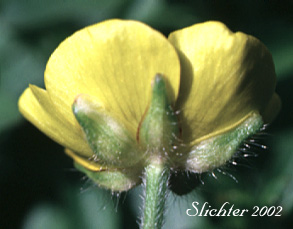 Characteristics:
Characteristics:
Creeping buttercup is a weedy species with several lax stems creeping along the ground. The stems root wherever the nodes touch the ground, forming new "clone" plants. The stems may reach a meter in length and the herbage is generally covered with stiff hairs although the upper leaf surfaces may be glabrous. The basal leaves (See photo below.) have petioles up to 40 cm long with compound ternate blades, the blade measuring from 3-7 cm long and the leaflets roughly triangular in outline. Each leaflet is stalked and the margins of the leaflets are lobed several times and once to twice serrate. The stem leaves are alternate, the lower ones with long petioles and upper leaves more bract-like.
The 5 greenish sepals are 5-7 mm long and quickly deciduous. Although most flowers have 5 petals, 6-9 are possible as evidenced by the photos above and at right. Individual petals are oblanceolate in shape, a bright shiny yellow, and range from 7-17 mm long. 30-80 stamens surround a globose cluster of pistils.
In the garden and yard, creeping buttercup is difficult to eradicate once it becomes established. It is easier to pull young plants before they become established and spread via their rooting stems. In severe infestations, using a pitchfork may help loosen the soil to dislodge the plants from the soil. I personally don't use weed killer, but that may work where creeping buttercup has spread widely through the yard.
Creeping buttercup may be found in moist disturbed places such as roadside ditches, streambanks, and moist yards. In woodlands, it is commonly found along roadsides where it can get a little more sunlight.
Creeping buttercup is native to Europe and has established itself in moist areas around much of the world. It is common in eastern North America.